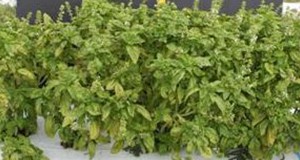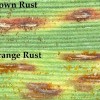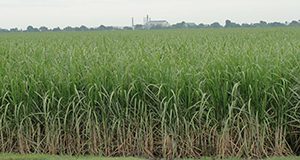Sugarcane (Saccharum interspecific hybrids) is the main source of sugar in the world. It is grown in more than 90 countries in tropical and subtropical regions. Cultivation techniques and production challenges vary by location (Rott 2017; Rott 2018). This 19-page document discusses characteristics of the sugarcane crop and pests affecting its production in Florida, which is the largest producer of sugarcane in the United States. Written by P. Rott, D. C. Odero, J. M. Beuzelin, R. N. Raid, M. VanWeelden, S. Swanson, and M. Mossler, and published by the UF/IFAS Agronomy Department, revised May 2018.
http://edis.ifas.ufl.edu/pi207
Tag: Richard Raid
Downy Mildew of Basil in South Florida

The yellowing of basil leaves could be an indication of the downy mildew of basil disease. This new destructive disease was first detected in south Florida in 2007 and has since spread to at least 42 states in the United States as well as many countries throughout Europe and Africa. This three-page fact sheet describes downy mildew of basil, including its symptoms and ways to control the disease. Written by Shouan Zhang, Jaimin S. Patel, Zelalem Mersha, Pamela D. Roberts, and Richard Raid, and published by the Plant Pathology Department.
http://edis.ifas.ufl.edu/pp271
Sugarcane Ring Spot

Ring spot, caused by the fungus Leptosphariea sacchari, is a disease of sugarcane that has been known to occur in Florida for over 80 years. Ring spot usually affects only the older leaves, and therefore is considered a minor disease. However, correctly identifying the disease in the field can help to reduce unnecessary chemical sprays. This two-page fact sheet outlines the symptoms and spread of the disease, as well as how to prevent and control Sugarcane Ring Spot. Written by P. Rott, J.C. Comstock, H.S. Sandhu, and R.N. Raid, and published by the Plant Pathology Department.
http://edis.ifas.ufl.edu/pp321
Sugarcane Orange Rust
 In June 2007, rust symptoms were observed on sugarcane cultivar CP80-1743 about six miles east of Belle Glade, Florida. The disease was confirmed as orange rust of sugarcane. It is hypothesized that rust spores were blown into the region as a disperse spore cloud from an unknown source rather than spread from a single or several small focal points. This 7-page fact sheet was written by P. Rott, S. Sood, J. C. Comstock, R. N. Raid, N. C. Glynn, R. A. Gilbert, and H. S. Sandhu, and published by the UF Department of Agronomy, May 2014.
In June 2007, rust symptoms were observed on sugarcane cultivar CP80-1743 about six miles east of Belle Glade, Florida. The disease was confirmed as orange rust of sugarcane. It is hypothesized that rust spores were blown into the region as a disperse spore cloud from an unknown source rather than spread from a single or several small focal points. This 7-page fact sheet was written by P. Rott, S. Sood, J. C. Comstock, R. N. Raid, N. C. Glynn, R. A. Gilbert, and H. S. Sandhu, and published by the UF Department of Agronomy, May 2014.
http://edis.ifas.ufl.edu/sc099
PP271 Downy Mildew of Basil in South Florida
PP271, a 3-page illustrated fact sheet by Shouan Zhang, Pamela D. Roberts, and Richard Raid, describes this new destructive disease that results in yellowing and cupping of the leaves of basil and ornamental plants related to it — distribution, symptoms, and control. Published by the UF Department of Plant Pathology, September 2009.
http://edis.ifas.ufl.edu/PP271
PPP6/PG100 2008 Florida Plant Disease Management Guide: Chemical Control Guide for Diseases of Vegetables, Revision No. 19
Revised! PPP-6, a 108-page publication by Ken Pernezny, Amanda Gevens, Tim Momol, Aaron Palmateer, Natalia Peres, Richard Raid, Pam Roberts, Gary Vallad, and Shousan Zhang, is a guide to lawful use of sprayable chemicals intended for control of plant diseases affecting vegetables grown in Florida. Published by the UF Department of Plant Pathology, September 2008.
http://edis.ifas.ufl.edu/PG100
